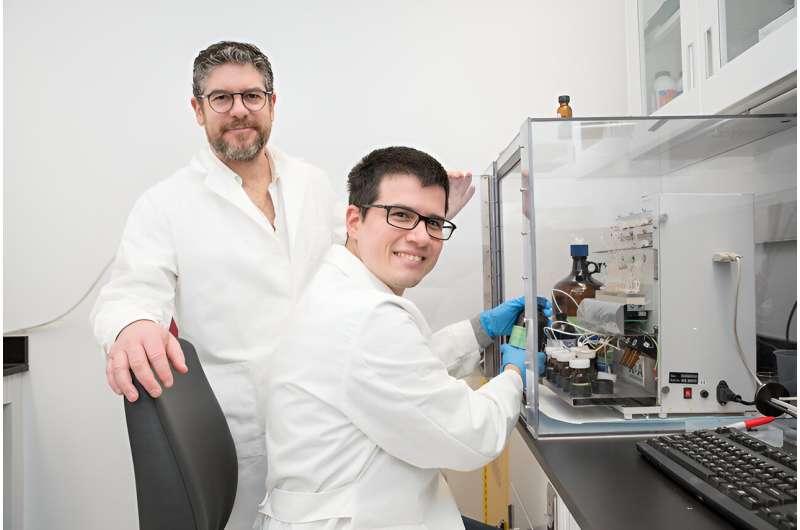Revolutionary research conducted by Canadian scientists at the Université de Montréal has successfully recreated and mathematically validated two molecular languages that are critical to the origin of life.
This groundbreaking study, titled “Programming chemical communication: allostery vs. multivalent mechanism,” was published on August 15, 2023 in the Journal of the American Chemical Society. It opens up new possibilities for the development of nanotechnologies with applications in biosensing, drug delivery, and molecular imaging.
Living organisms consist of countless nanomachines and nanostructures that communicate with each other to create higher-order entities capable of crucial functions such as movement, cognition, survival, and reproduction.
The study’s lead researcher, Alexis Vallée-Bélisle, a bioengineering professor at UdeM, explains, “The emergence of life depends on the development of molecular languages, also known as signaling mechanisms, which ensure that all molecules within living organisms collaborate to accomplish specific tasks.”
In yeast, for example, billions of molecules communicate and synchronize their activities to initiate mating upon the detection and binding of a mating pheromone, explains Vallée-Bélisle, who holds a Canada Research Chair in Bioengineering and Bionanotechnology.
“As we enter the age of nanotechnology, many scientists believe that our ability to understand and effectively utilize the molecular languages developed by living organisms is key to designing and programming more sophisticated and practical artificial nanosystems,” adds Vallée-Bélisle.
Two Distinct Languages
Allostery is a well-known molecular language that operates on a “lock-and-key” mechanism. When one molecule binds and alters the structure of another molecule, it directs it to trigger or inhibit an activity.
On the other hand, multivalency, also known as the chelate effect, is a lesser-known molecular language that functions like a puzzle. As one molecule binds to another, it either facilitates or hinders the binding of a third molecule by increasing its binding interface.
Although these two languages exist in all molecular systems of living organisms, scientists have only recently begun to understand their rules and principles. Now, they can use these languages to design and program innovative artificial nanotechnologies.

“Given the complexity of natural nanosystems, nobody was previously able to compare the fundamental rules, advantages, and limitations of these two languages on the same system,” remarks Vallée-Bélisle.
To address this challenge, Dominic Lauzon, a doctoral student and the study’s lead author, conceived the idea of creating a DNA-based molecular system capable of functioning using both languages. “DNA is like Lego bricks for nanoengineers,” explains Lauzon. “It’s a remarkable molecule that offers simple, programmable, and user-friendly chemistry.”
Simple Mathematical Equations for Antibody Detection
The researchers discovered that simple mathematical equations could effectively describe both languages, revealing the parameters and design principles necessary to program communication between molecules within a nanosystem.
For instance, while the multivalent language allowed for control of both sensitivity and cooperativity in the activation and deactivation of molecules, the corresponding allosteric translation only enabled control over sensitivity of the response.
Armed with this newfound understanding, the researchers employed the language of multivalency to design and engineer a programmable antibody sensor capable of detecting antibodies across various concentration ranges.
“As demonstrated during the recent pandemic, our ability to precisely monitor antibody concentrations in the general population is a powerful tool for determining individual and collective immunity,” says Vallée-Bélisle.
In addition to expanding the synthetic toolbox for creating the next generation of nanotechnology, this discovery sheds light on why some natural nanosystems may prefer one language over the other for communicating chemical information.
More information:
Dominic Lauzon et al, Programming chemical communication: allostery vs multivalent mechanism, Journal of the American Chemical Society (2023). DOI: 10.1021/jacs.3c04045
Denial of responsibility! TechCodex is an automatic aggregator of the all world’s media. In each content, the hyperlink to the primary source is specified. All trademarks belong to their rightful owners, and all materials to their authors. For any complaint, please reach us at – [email protected]. We will take necessary action within 24 hours.

Jessica Irvine is a tech enthusiast specializing in gadgets. From smart home devices to cutting-edge electronics, Jessica explores the world of consumer tech, offering readers comprehensive reviews, hands-on experiences, and expert insights into the coolest and most innovative gadgets on the market.
Denial of responsibility! TechCodex is an automatic aggregator of Global media. In each content, the hyperlink to the primary source is specified. All trademarks belong to their rightful owners, and all materials to their authors. For any complaint, please reach us at – [email protected]. We will take necessary action within 24 hours.

